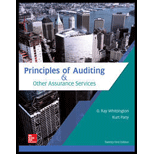
Principles Of Auditing & Other Assurance Services
21st Edition
ISBN: 9781259916984
Author: WHITTINGTON, Ray, Pany, Kurt
Publisher: Mcgraw-hill Education,
expand_more
expand_more
format_list_bulleted
Question
Chapter 9, Problem 28RQ
To determine
Explain the relationship that exist between the projected misstatement and tolerable misstatement in order for the auditors to conclude that an account balance is acceptable.
Expert Solution & Answer
Want to see the full answer?
Check out a sample textbook solution
Students have asked these similar questions
After describing a threat/risk in either the revenue cycle (i.e., in sales and cash collection activities) or the expenditure cycle (i.e., in purchases or cash disbursement activities).
What are specific internal controls that might be applied to mitigate each of the threats we've identified?
Compare and contrast the procedures for lodging an objection in Jamaica with those of Trinidad and Tobago.
The actual cost of direct labor per hour is $16.25 and the standard cost of direct labor per hour is $15.00. The direct labor hours allowed per finished unit is 0.60 hours. During the current period, 4,500 units of finished goods were produced using 2,900 direct labor hours. How much is the direct labor rate variance? A. $3,625 favorable B. $3,625 unfavorable C. $4,350 favorable D. $4,350 unfavorable
Chapter 9 Solutions
Principles Of Auditing & Other Assurance Services
Ch. 9 - Prob. 1RQCh. 9 - Prob. 2RQCh. 9 - Prob. 3RQCh. 9 - Prob. 4RQCh. 9 - Prob. 5RQCh. 9 - Prob. 6RQCh. 9 - Prob. 7RQCh. 9 - Prob. 8RQCh. 9 - Prob. 9RQCh. 9 - Prob. 10RQ
Ch. 9 - Prob. 11RQCh. 9 - Prob. 12RQCh. 9 - What is a dual-purpose test?Ch. 9 - Prob. 14RQCh. 9 - Prob. 15RQCh. 9 - Prob. 16RQCh. 9 - What would be the difference between an attributes...Ch. 9 - Prob. 18RQCh. 9 - Prob. 19RQCh. 9 - Prob. 20RQCh. 9 - Prob. 21RQCh. 9 - Prob. 22RQCh. 9 - Prob. 23RQCh. 9 - Prob. 24RQCh. 9 - Prob. 25RQCh. 9 - Prob. 26RQCh. 9 - Prob. 27RQCh. 9 - Prob. 28RQCh. 9 - Prob. 29QRACh. 9 - Prob. 30QRACh. 9 - Prob. 31QRACh. 9 - Prob. 32QRACh. 9 - Prob. 33QRACh. 9 - Prob. 34QRACh. 9 - Prob. 35QRACh. 9 - Prob. 36QRACh. 9 - Prob. 37AOQCh. 9 - Prob. 37BOQCh. 9 - Prob. 37COQCh. 9 - Prob. 37DOQCh. 9 - Prob. 37EOQCh. 9 - Prob. 37FOQCh. 9 - Prob. 37GOQCh. 9 - Prob. 37HOQCh. 9 - Prob. 37IOQCh. 9 - Prob. 37JOQCh. 9 - Prob. 37KOQCh. 9 - Prob. 37LOQCh. 9 - Prob. 38OQCh. 9 - Prob. 39OQCh. 9 - For each term in the first column below, identify...Ch. 9 - Prob. 41OQCh. 9 - Smith, Inc. Rachel Robertson wishes to use...Ch. 9 - Prob. 43OQCh. 9 - Prob. 44PCh. 9 - Prob. 45PCh. 9 - Prob. 46PCh. 9 - Prob. 47PCh. 9 - In the audit of Potomac Mills, the auditors wish...Ch. 9 - Prob. 49PCh. 9 - Prob. 50PCh. 9 - Prob. 51PCh. 9 - Prob. 52ITC
Knowledge Booster
Similar questions
- On January 1 of the current year, Piper Company issues a 4-year, non-interest-bearing note with a face value of $8,000 and receives $4,952 in exchange. The recording of the issuance of the note includes a: a. credit to Notes Payable for $4,952. b. credit to Discount on Notes Payable for $3,048. c. debit to Discount on Notes Payable for $3,048. d. debit to Cash for $8,000.arrow_forwardPLease helparrow_forwardPLEASE HELParrow_forward
- Hy expert provide answer with calculationarrow_forwardDuring September, the assembly department completed 10,500 units of a product that had a standard materials cost of 3.0 square feet per unit at $2.40 per square foot. The actual materials purchased consisted of 22,000 square feet at $2.60 per square foot, for a total cost of $57,200. The actual material used during this period was 25,500 square feet. Compute the materials price variance and materials usage variance.arrow_forwardBluesy Electronics recorded the following financial data: Net Sales $720,500 Average Inventory at Cost = $80,200 Gross Margin Percentage = 42% Calculate the GMROI.arrow_forward
- Need help this question solutionarrow_forwardXYZ Company has a gross profit margin of 0.30, an operating profit margin of 18%, a total asset turnover ratio of 2.0x, and cost of goods sold of $700,000. The company's tax rate is 35%, and it has no debt. Calculate XYZ Company's Return on Assets (ROA).arrow_forwardMON Pools builds custom swimming pools. MON budgets that they will build 16 pools during the month of June at a price of $22,750 per pool. The actual pools built by MON during June were 13 pools at a price of $23,420 per pool. What is the Flexible Budget Variance for June?arrow_forward
arrow_back_ios
SEE MORE QUESTIONS
arrow_forward_ios
Recommended textbooks for you
 Auditing: A Risk Based-Approach (MindTap Course L...AccountingISBN:9781337619455Author:Karla M Johnstone, Audrey A. Gramling, Larry E. RittenbergPublisher:Cengage Learning
Auditing: A Risk Based-Approach (MindTap Course L...AccountingISBN:9781337619455Author:Karla M Johnstone, Audrey A. Gramling, Larry E. RittenbergPublisher:Cengage Learning Auditing: A Risk Based-Approach to Conducting a Q...AccountingISBN:9781305080577Author:Karla M Johnstone, Audrey A. Gramling, Larry E. RittenbergPublisher:South-Western College Pub
Auditing: A Risk Based-Approach to Conducting a Q...AccountingISBN:9781305080577Author:Karla M Johnstone, Audrey A. Gramling, Larry E. RittenbergPublisher:South-Western College Pub

Auditing: A Risk Based-Approach (MindTap Course L...
Accounting
ISBN:9781337619455
Author:Karla M Johnstone, Audrey A. Gramling, Larry E. Rittenberg
Publisher:Cengage Learning

Auditing: A Risk Based-Approach to Conducting a Q...
Accounting
ISBN:9781305080577
Author:Karla M Johnstone, Audrey A. Gramling, Larry E. Rittenberg
Publisher:South-Western College Pub